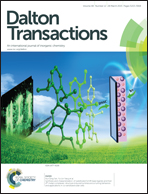Heterobimetallic rhenium nitrido complexes containing the Kläui tripodal ligand [Co(η5-C5H5){P(O)(OEt)2}3]−†
Abstract
Rhenium nitrido complexes containing the Kläui tripodal ligand [Co(η5-C5H5){P(O)(OEt)2}3]− (LOEt−) have been synthesised and their reactions with [IrI(cod)Cl]2 (cod = 1,5-cyclooctadiene) and [RhII2(OAc)4] (OAc− = acetate) have been studied. The treatment of [Bun4N][ReVI(N)Cl4] with NaLOEt in methanol afforded the ReVI nitride [ReVI(LOEt)(N)Cl(OMe)] (1). Reactions of 1 with [IrI(cod)Cl]2 and [RhII2(OAc)4] gave the μ-nitrido complexes [(LOEt)(OMe)ClReVI(μ-N)IrI(cod)Cl] (2) and [RhII2(OAc)4{(μ-N)ReVI(LOEt)(OMe)Cl}2] (4), respectively. [(LOEt)Cl(PPh3)ReV(μ-N)IrI(cod)Cl] (3) and [(LOEt)Cl(PPh3)ReVI(μ-N)IrI(cod)Cl][PF6] (3·PF6) have been synthesised from the reactions of [IrI(cod)Cl]2 with [ReVLOEt(N)Cl(PPh3)] and [ReVILOEt(N)Cl(PPh3)](PF6), respectively. Similarly, the redox pair [RhII2(OAc)4{(μ-N)ReV(LOEt)(PPh3)Cl}2] (5) and [RhII2(OAc)4{(μ-N)ReVI(LOEt)(PPh3)Cl}2](PF6)2 (5·(PF6)2) have been synthesised from the reactions of [Rh2(OAc)4] with [ReVLOEt(N)Cl(PPh3)] and [ReVILOEt(N)Cl(PPh3)](PF6), respectively. While [(LOEt)Cl2RuVI(μ-N)IrI(cod)] (6) was obtained from [RuVI(LOEt)(N)Cl2] and [IrI(cod)Cl]2, the interaction between [RuVI(LOEt)(N)Cl2] and [RhII2(OAc)4] in CH2Cl2 is reversible. The crystal structures of complexes 2, 3, 3·PF6, 5, 5·(PF6)2 and 6 have been determined. X-ray crystallography indicates that the nitrido bridges in 2, 3, 3·PF6 and 6 can be described as M N—Ir (M = Re, Ru) showing Ir–N multiple bond character, whereas the interaction between Re
N—Ir (M = Re, Ru) showing Ir–N multiple bond character, whereas the interaction between Re![[triple bond, length as m-dash]](https://www.rsc.org/images/entities/char_e002.gif) N and Rh in 5 and 5·(PF6)2 is mostly of the donor–acceptor type. The electrochemistry of the Re nitrido complexes has been investigated by cyclic voltammetry.
N and Rh in 5 and 5·(PF6)2 is mostly of the donor–acceptor type. The electrochemistry of the Re nitrido complexes has been investigated by cyclic voltammetry.
![Graphical abstract: Heterobimetallic rhenium nitrido complexes containing the Kläui tripodal ligand [Co(η5-C5H5){P(O)(OEt)2}3]−](/en/Image/Get?imageInfo.ImageType=GA&imageInfo.ImageIdentifier.ManuscriptID=C5DT00093A&imageInfo.ImageIdentifier.Year=2015)

 Please wait while we load your content...
Please wait while we load your content...